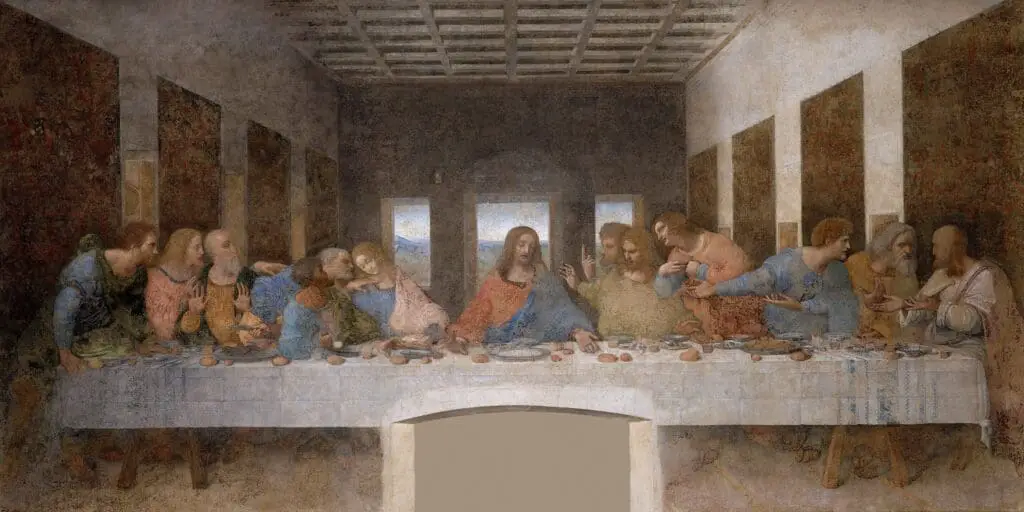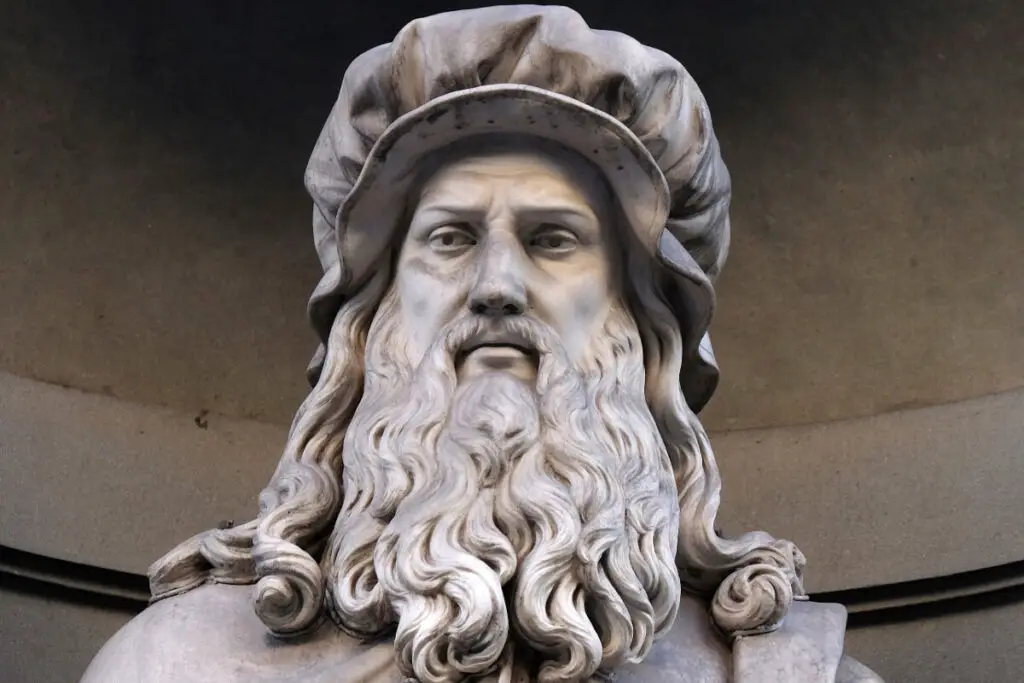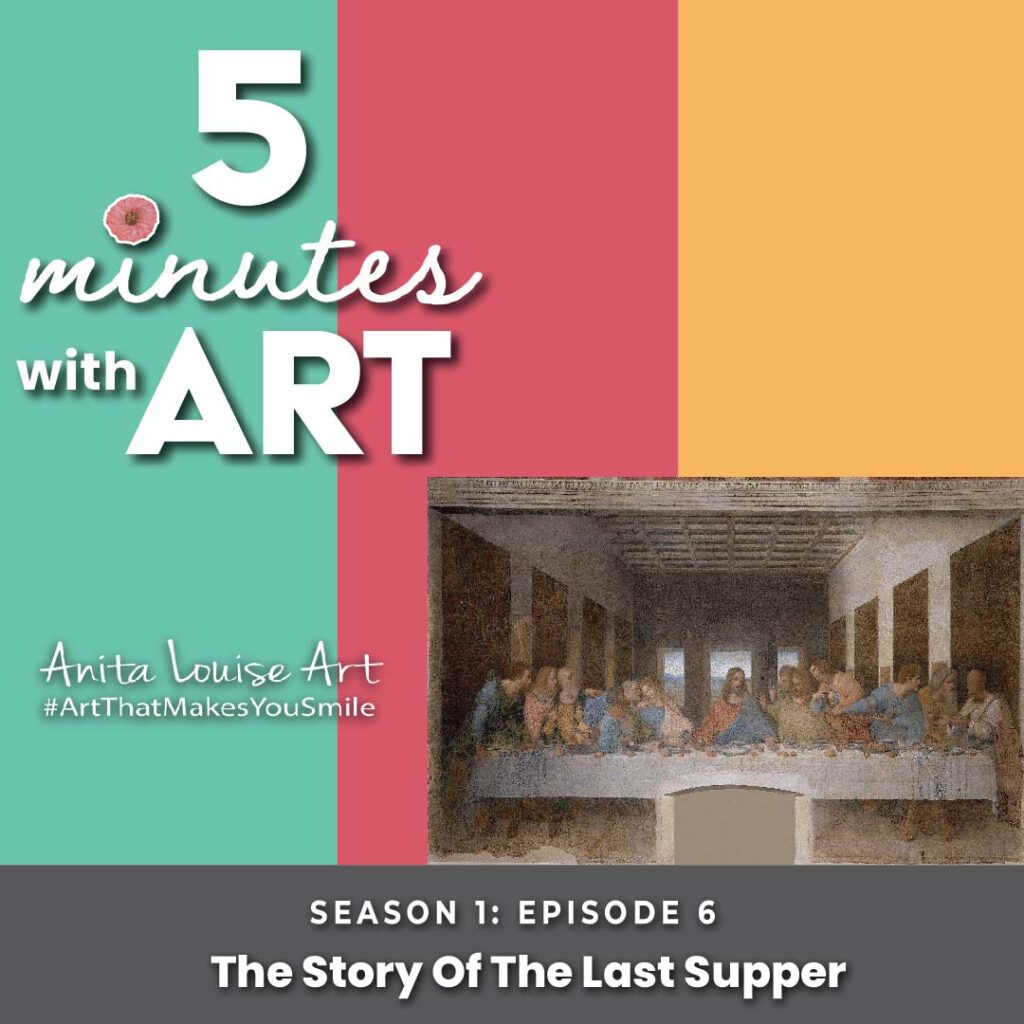Leonardo da Vinci only finished painting one mural during his lifetime, known as the Last Supper. It is one of the most famous paintings of the Last Supper ever created.
Duke Ludovico Sforza commissioned Leonardo to paint the Last Supper mural. What makes the Last Supper mural so unique is that he painted it at the exact time when Christ told the Apostles during The Last Supper meal that one of them would betray him. Leonardo showed the apostles’ reactions, including Judas, who betrayed Christ.
Table of Contents
- Leonardo da Vinci And The Last Supper Commission
- Leonardo da Vinci And The Last Supper Painting Inspiration
- Leonardo da Vinci, The Last Supper, Christ, And The Apostles
- The Influences Of Leonardo’s The Last Supper Painting
- The Legend Of A Criminal And Judas
- 10 Reasons Why I Adore “The Last Supper”
- Frequently Asked Questions About Leonardo’s The Last Supper Painting
- Related Questions
Leonardo da Vinci And The Last Supper Commission

The wall painting of The Last Supper was commissioned by Ludovico Sforza, the Duke of Milan and one of Leonardo’s essential patrons. We know Sforza commissioned this as the Sforza coat of arms appeared with the family initials on the mural.
In 1482, at 30, Leonardo left Tuscany for Milan to be the painter of Duke Ludovico Sforza and his wife, Duchess Beatrice d’Este. This patronage saw Leoncaro commissioned to paint the Last Supper about ten years later.
For Duke Sforza, The Last Supper painting was the centerpiece of his planned mausoleum at the recently completed Dominican Church.
The Last Supper was painted for the refectory of the Dominican monastery—Santa Maria Delle Grazie in Milan. At the time, having a Last Supper painting on the refectory walls was popular as it allowed the monks and nuns to eat their meal in the presence of Jesus’ last meal.
Leonardo da Vinci’s painting The Last Supper on a refectory wall would not have been that unusual, but it is iconic because of how Leonardo painted it.
The Last Supper mural was supposed to take only a year to complete, but Lenardo was a notoriously slow and thoughtful painter; he started it in 1494 but did not complete it until 1498.
Leonardo was known to paint one day from dawn to dust but did not show up to paint for 3 or 4 days. This type of work was beyond the Convent’s prior understanding, which asked Duke Sforza to intervene and try to push Leonardo to work faster.
Leonardo told the Duke that if the Convent prior continued to hound him to finish the mural, he might use the prior’s face as his model of the Apostle Judas, who betrayed Christ.
Leonardo da Vinci never did make good on his threat that he would paint the Convent prior of Judas, who betrayed Christ. We know that he had a tough time deciding how to paint Judas and what Judas should look like, and he could not find a suitable model for Judas.
Leonardo wanted a mature person with the mark of treason to be his model for Judas; we have no evidence that the Convent prior was the model for Judas in this mural.
Leonardo da Vinci And The Last Supper Painting Inspiration
Leonardo chose to paint The Last Supper, showing the exact moment that Jesus told the disciples that one of them would betray him. One of the exciting aspects of this painting is that Leonardo tried to show the personalities of the apostles and their reaction to Christ, telling them that one of them would betray him.

In the painting, he shows each apostle’s reactions according to their personalities. Leonardo, a scientist who studied the human body, believed that each man’s posture, gestures, and expression would appear in their personality.
The painting of The Last Supper is not just of Christ and the apostles around the table at The Last Supper, but it is also a work of art that depicts the personality and reaction of the Apostles.
Because The Last Supper painting is filled with many emotions from the Apostles and Christ, it is also a very complex artistic study of emotions that centers on betrayal. In this case, the betrayal was that someone in that room would betray Christ.
The King James Version of the Bible states this about Christ and the betrayal. When Jesus made this proclamation to the Apostles, Leonardo used it as a setting for this painting. The King James version of the Bible says this about the moment when Christ told the Apostles one would betray him:
20 Now when the even was come, he sat down with the twelve.
Matthew 26:20-22 (King James Version Of The Bible)
21 And as they did eat, he said, Verily I say unto you, that one of you shall betray me.
22 And they were exceeding sorrowful, and began every one of them to say unto him, Lord, is it I?
This exact historical moment inspired Leonardo to paint this painting after Christ told the apostles someone would betray him. He painted it when the apostles were unsure who had betrayed Christ, but they knew the betrayer was sitting among them at that moment.
Leonardo da Vinci, The Last Supper, Christ, And The Apostles
At first, Leonardo’s version of The Last Supper seems to be very neatly arranged. There is a sizeable, extensive tale, and the Apostles are all on his right or left. But the painting itself is filled with symbolism and emotions.

Listen To Our Podcast About The Story Of The Last Supper below or by clicking here.
The Influences Of Leonardo’s The Last Supper Painting
Leonardo da Vinci’s masterpiece, The Last Supper, is one of the most iconic paintings in history. The painting depicts the moment Jesus Christ reveals to his disciples that one of them will betray him.
The Last Supper has been praised for its technical mastery and the emotional depth of its composition. It has also been the subject of much analysis and interpretation over the years, with many scholars and art enthusiasts speculating on the meaning behind the painting’s various elements.
Here are some essential aspects of Leonardo’s Last Supper painting:
Jesus Christ in The Last Supper Painting
In Leonardo’s painting of The Last Supper, Jesus Christ is in a traditional red and blue robe at the center of the table; Christ also has a beard.
We do not see the halo above Christ’s head in the painting. Placing a halo above Christ’s head was common during this time.
Instead, we see Christ in front of a window, and the window’s light almost gives an illusion of a halo. Some have also said that Leonardo did not paint the halo as he wanted to show the viewers that Christ was still human and had not yet endured the pain and suffering of being crucified on the cross.
Jesus also gestures towards a glass of wine and bread to show us the importance of communion or sacrament.
Jesus’ expression is also significant as his head is lowered, and there is a reverence about him, which is in deep contrast to the noticeable agitation of the apostles; there is a calmness and serenity to Jesus that we do not see with any of his apostles.
The Apostles In The Last Supper Painting
The Apostles’ reaction in The Last Supper painting is one of the unique things about this classic painting of Christ. Each of the apostles seems to have different reactions.
Here are some of the noticeable reactions that the apostles give in the Last Supper painting.

- James – James, also known as James The Great, is to Christ’s left around the table, and he seems to throw his hands up as if in total disbelief.
- Thomas – Thomas, also known as Doubting Thomas, is right by James and seems to point upward to Heaven as if not to believe or doubt what he hears.
- Peter – Peter has a knife in his hand that symbolizes the fact that later, he will cut off the ear of a soldier when he attempts to arrest Jesus.
- John – The Apostle John is sitting at Christ’s right and almost seems to swoon or cry out loud.
- Judas – Judas Iscariot, who betrayed Jesus, is holding on to his purse or his award of silver coins he got for betraying Christ, and he is backing away from Peter.
All the other Apostles around the table seem to grieve, debate, or whisper among themselves to find out who will betray Christ. And in the center of all the reactions and commotion, Christ sits there very calmly, almost as if He is saying, I know this is my destiny and fate.
In the Last Supper Painting, the Apostles Are in 4 Groups of 3.
One of the most striking features of Leonardo da Vinci’s masterpiece, The Last Supper, is how the apostles are arranged in the painting.
Instead of being depicted in a single row or scattered randomly around the table, the apostles are grouped into four sets of three, each with distinct dynamics and interactions.
This intentional arrangement has been the subject of much speculation and analysis over the years, with scholars and art enthusiasts attempting to uncover the symbolic significance of this unusual composition.
Here are how these groups are intentionally arranged around the Last Supper table:
- Group 1 – Bartholomew, James, and Andrew.
- Group 2 – Judas, Peter, and John the Beloved.
- Group 3 – Thomas, James the Great, Philip.
- Group 4 – Matthew, Thaddeus, Simon
The Legend Of A Criminal And Judas
There is a story of who Judas is in this painting; this story is not verified as we have no concrete records to know who the model was for Judas Iscariot in The Last Supper.
Leonardo was looking for the perfect model of Judas when he heard about a man who was a hardened criminal in a local prison. He visited the man and felt his face was perfect for Judas.
He asked the prison warden if the man could come and sit for him as a model for Judas at the Last Supper. The warden agreed and sent the prisoner with chains and two guards for him to sit as a model for the painting.
For days, the man sat with his stony and hardened face as a model for Leonardo. When he finished painting Judas, he showed his final work to the prisoner.
Upon seeing the work, the prisoner broke down in tears and cried and said to Leonardo, “Do you not remember me?” The prisoner then exclaims that he had sat as a model for Leonardo as his model for Christ years earlier.
Whether that story is true or not, it does make for a good story as to how Leonardo was able to paint the face of Judas in the Last Supper Mural. We know that Leonardo had a hard time deciding how to paint the face of Judas.
The Last Supper by Leonardo da Vinci continues to be one of the most important works of art ever painted about Christ’s Last Supper with the Apostles.
10 Reasons Why I Adore “The Last Supper”
Whenever someone mentions renowned artworks, my mind instantly veers towards “The Last Supper” by Leonardo da Vinci. This painting isn’t just a masterpiece; for me, it encapsulates a myriad of emotions, technical prowess, and historical context that make it stand out from other works.
Here are ten reasons why I, and many like me, are endlessly captivated by “The Last Supper.”
- Leonardo’s Deep Connection with the Biblical Story: The painting is a testament to Leonardo’s deep understanding of the biblical narrative. It’s evident in the details that he had studied and internalized the story of Christ’s last meal with His apostles. When I stand before this painting, I feel as if Leonardo is narrating the story to me personally, making it resonate on a deeper level.
- A Showcase of Human Emotion: What never ceases to amaze me is how Leonardo brilliantly captured the spectrum of human emotion. From shock to disbelief, every apostle’s reaction to Jesus’ revelation that one of them would betray Him is palpable. This level of emotional detail allows us, the viewers, to empathize and engage with each character.
- The Serenity of Christ: Amidst the flurry of emotions displayed by the apostles, Christ remains the eye of the storm – serene and composed. This contrast emphasizes His divine nature and showcases Leonardo’s skill in portraying complex emotional interplays.
- The Quintessential Last Supper Representation: Many artists have depicted the Last Supper over the years. Yet, Leonardo’s version stands as the most iconic. For me, it sets the gold standard for visualizing this biblical event, making other renditions pale in comparison.
- Masterful Use of Perspective: The architectural details, the converging lines towards Christ, and the spatial arrangement exemplify Leonardo’s genius in drawing attention to the central figure: Jesus.
- Intimate Atmosphere: Despite being a grand scene, an intimate atmosphere engulfs “The Last Supper.” Every time I look at it, I feel like I’m at the table with them, sharing their emotions and the gravity of the moment.
- The Intricate Details: From the food on the table to the folds of the robes, the intricate details Leonardo incorporated never fail to impress me. They showcase his meticulous nature and dedication to his craft.
- A Historical Window: The painting provides a window into the cultural and societal norms of the time it was created, enriching our understanding of history and art’s evolution.
- Its Enduring Legacy: Despite the wear and tear it has suffered over the centuries, “The Last Supper” inspires and captivates. It reminds me of the timeless nature of true art and how it can touch souls across generations.
- A Personal Journey: Every time I engage with “The Last Supper,” I discover something new, something I hadn’t noticed before. For me, it’s not just a painting; it’s a journey. A journey that, with each visit, deepens my appreciation and understanding of art, history, and spirituality.
“The Last Supper” is more than just paint on a wall. It’s a narrative, an emotion, a historical document, and a testament to Leonardo’s genius. For all these reasons and more, it remains close to my heart, urging me to return to it time and time again.
Anita Louise Art is dedicated to art education, great artists, and inspiring others to find and create their art. We love art that uplifts and inspires. #ArtToMakeYouSmile! #ArtToMakeYouHappy!
If you want to see any of my art, you can find out more by clicking here. If you are interested in what inspires me and my paintings, you can discover more by clicking here.
We have a free newsletter and would love you to be part of our community; you can subscribe to the newsletter by clicking here. If you have any questions, I would be happy to talk to you anytime. You can reach me, Anita, by clicking here.
Subscribe to our Anita Louise Art YouTube Channel with great videos and information by clicking here.
Frequently Asked Questions About Leonardo’s The Last Supper Painting
What is The Last Supper painting?
The Last Supper is a late 15th-century mural by Leonardo da Vinci that depicts the last meal shared by Jesus Christ and his disciples before his crucifixion.
Where is The Last Supper painting located?
The Last Supper painting is on a wall in the dining hall of the former Dominican monastery of Santa Maria delle Grazie in Milan, Italy.
What is the size of The Last Supper painting?
The painting is approximately 15 feet by 29 feet.
How long did it take Leonardo da Vinci to paint The Last Supper?
The exact time it took Leonardo to complete the painting is unknown, but it is estimated to have taken him around three years.
What is the symbolism behind The Last Supper painting?
The painting is full of symbolism, from how the apostles are arranged to the various objects and gestures depicted in the scene. Some of the most commonly discussed symbols include the bread and wine on the table, which represent the body and blood of Christ, and the positioning of the apostles in groups of three, which may represent the Holy Trinity.
Why is The Last Supper painting important?
The Last Supper is considered one of the greatest works of art ever created and is notable for its technical mastery, emotional depth, and intricate symbolism. The painting has had a lasting impact on art history and popular culture and continues to be studied and admired by art enthusiasts worldwide.
Is The Last Supper painting deteriorating?
Yes, the painting has suffered significant damage over the years, both from the effects of time and from various attempts at restoration. Today, it is carefully monitored and protected to preserve its fragile state.
Related Questions
Did Michelangelo And Leonardo Know Each Other?
Michelangelo and Leonardo da Vinci knew each other and were considered bitter rivals. The two men knew each other, but they did like each other. They were both asked to do a commission on the Council Hall of the Palazzo Vecchio.
By clicking here, you can learn more by reading Did Michelangelo And Leonardo Know Each Other?.
What Did Leonardo da Vinci Contribute To Medicine?
Leonardo da Vinci contributed a lot to the medical field of study. His work contributed to our understanding of anatomy, medical physics, biomedical engineering, and neuroscience. He was fascinated with the human body as an artist and scientist.
By clicking here, you can learn more by reading What Did Leonardo da Vinci Contribute To Medicine?.

